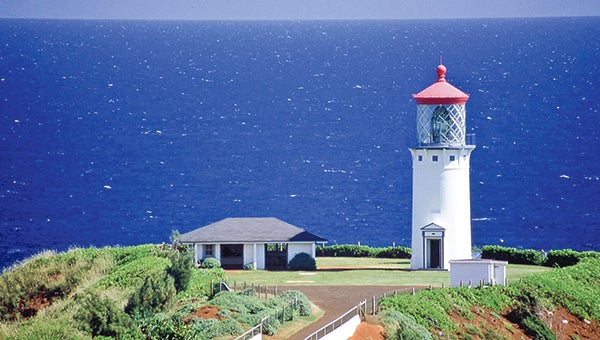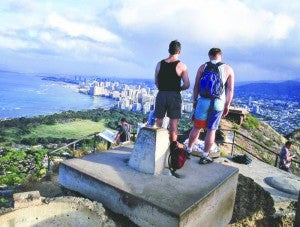Warm Waikiki
Published 12:49 pm Saturday, February 20, 2016

Diamond Head Lighthouse has warned of offshore reefs for over a hundred years. — Submitted | Archie Howell
by James D. Howell
I sit on the larger of several rocks that anchor a short breakwater. Today, there’s not much to break. Small, almost apologetic, waves, lap gently at the sand. The air is lethargic; most beach occupants are as well.
I roll up my pants legs, remove my shoes and socks, and tie the shoelaces together. I can hang them from my camera backpack or from my belt, leaving my hands free for the camera. I set the tripod, pick it up and reset it a little to my left. There’s a little eye candy that I wish to include in the film frame.
I seem to be the only person on the beach in long pants. I’m trying to look casual about it, but I don’t think anyone really cares. Most others are lost in their world of eyes closed sun worshipping or walking the surf line looking about in a distracted manner.
Here in front of me is one of the most famous beaches on earth — the beach at Waikiki, Hawaii. To my left, hotels and resorts large and small compete for beachfront. Some have swimming pools within their properties for guests that prefer fresh water and salt air. Some are mostly hidden up narrow walkways. A short glance up reveals that any and all guest houses and hotels that open up to the beach have guest rooms with balconies and views. It must be something glorious to awaken, open a patio door and behold the grand beach.
The most populated area of Oahu Island is the south shore. Cities of Honolulu, Waikiki, Pearl Harbor and Ewa Beach are all located on the south shore. Smaller townships, villages and commercial interests extend from the shoreline to a mountain range that essentially divides the island.
Here, the beach starts with the fabled Hilton Village assortment of towers restaurants and entertainment venues. Countless movies and television shows have been recorded or broadcast live from their property, that includes the Duke Kahanamoku Lagoon. Countless celebrities have had their beginnings and furthered their careers in the lounges of the Hilton Village.
From the lagoon the beach curves slightly, roughly parallel to Kalakaua Avenue, and ends at the Honolulu Zoo, about a mile and a half total. To the east from the zoo is a series of hotels, condominiums and smaller parks, ending with Diamond Head. The extinct volcanic vent is a very well known and recognized landmark of tropical paradise, visible on anything that has to do with Hawaii in general and Waikiki in particular. It anchors the eastern point of the south shore.
Diamond Head appears flat sided from a horizontal view, but it is round. The dormant volcano vent is one of the newer additions to the Hawaii landmass, a mere 200,000 years old. The entire island chain was created by tectonic plate movement, a “hotspot” in the earth’s crust. The more active “big island” of Hawaii is still being formed.
Since about 1900, Diamond Head has been a part of the military establishment, during its term as a territory and then, in 1959, as a state.
 During World War II, it housed some of the more secret aspects of war, and served as a visual lookout point for the south shore of Oahu. Today, it’s still a part of the military, but it has become a frequently visited park, with set hours of operation. The entrance is through a tunnel on the on the northeast side.
During World War II, it housed some of the more secret aspects of war, and served as a visual lookout point for the south shore of Oahu. Today, it’s still a part of the military, but it has become a frequently visited park, with set hours of operation. The entrance is through a tunnel on the on the northeast side.
I arrive at the Diamondhead entrance just after its opening and make my way through to the parking area alongside the administrative buildings. I read about the trails and points of interest. Today, I’ll climb the 200-plus steps, some 560 feet up through tunnels and uneven ground. The view from the top is worth it, I’m told, and I’m ready for the wide open look at Waikiki and Honolulu.
I’m a little out of breath, but I made it and the view is definitely worth it. To the west beyond Waikiki is Honolulu and the hazy south western mountains. Close beside Beach Road, below is the Diamond Head beach along the south and east sides. There’s the Diamond Head Lighthouse and park, also.
Surf is up today just off the point and many surfers are enjoying their boards. Wooden longboards were the style for pre- and post-World War II surfing. It paved the way for imagination and the newer materials seen today.
Longboards seemed to work better in smaller surfs but were not maneuverable enough for the enthusiast. Out on the water today are splashes of color doing runs and cutbacks impossible on longboards.
I set the tripod, record the spectacular view, retrace my steps and call it a day. Tomorrow, I’ll check out the windward side of Oahu.
JAMES D. “ARCHIE” HOWELL is a Southampton County native and 1955 graduate of Franklin High School. He can be reached at archiepix@kingwoodcable.com.







